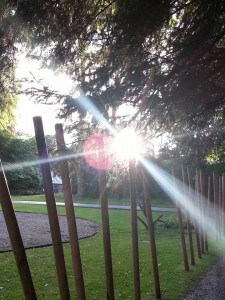In the last 12 months, I’ve witnessed a huge increase in the interest we have in teaching children mindfulness.
Compared to how this was 12 years ago when I first had a hunch we should be doing this… well it is simply astounding.
I was never formally taught mindfulness.  My meditation teacher, the late Kim McManus, taught meditation groups to help with spiritual development. However the by-products of this were improved self esteem, energy levels and an amazing sense of trust in our heart-felt intuition. But she didn’t call it mindfulness – she called it meditation.
My meditation teacher, the late Kim McManus, taught meditation groups to help with spiritual development. However the by-products of this were improved self esteem, energy levels and an amazing sense of trust in our heart-felt intuition. But she didn’t call it mindfulness – she called it meditation.
I didn’t think there was a difference until I was on a forum in the USA discussing the subject with someone who quickly corrected me when I used the word ‘meditation’; it was ‘mindfulness’ we were teaching, not ‘meditation’. The latter was seen as being religious whereas mindfulness was not – I found this fascinating that such a difference existed!
So what is mindfulness and how does it differ to meditation?
Let’s put it this way…
…meditation (for me) is the big picture term for all different ways in which we connect to our inner essence using a wide variety of activities or tools.
One of those tools/activities is mindfulness. So is yoga, tai chi and chi gong which are all forms of moving meditation.
In addition to this, you have tools such as crystals, mandalas, labyrinths, singing bowls, and guided meditation using visual imagery that all fall under the word ‘meditation’.
So for me, meditation covers everything that we can use to help this heart-felt connection.
Self-Awareness
Mindfulness (which I originally called ‘self awareness’ in my first book Calm Kids) is a practice of noticing the thoughts, emotions and sensations in the body as they arise. The intention is to help remove the fog or distraction of these so that we can connect to a well of inner-peace inside.
This doesn’t mean we don’t have difficult days. It means that we witness that difficult day and all that it brings up in a mindful way. We pay attention to this with a gentle curiosity in each moment and without judgement.
As we continuously do this, we sense peace through the freedom we have to surrender to the moment (rather than the judgement of how life should be). When I say ‘remove the fog’ it’s not about doing this with force. In fact we need to practice great gentleness and compassion for the self to do this.
As you can see mindfulness isn’t something you can just sum up in a few words! 🙂
Mindfulness Origins
Mindfulness originates from Buddhism (so I was rather confused when the word ‘meditation’ was seen as religious!) but the work of great writers like Jon Kabat-Zinn and Rob Nairn have brought mindfulness meditation into mainstream practice – particularly in medical, science and educational settings.
This paper by Jon Kabat-Zinn makes interesting reading about a man who was trying to make mindfulness practice accessible to American society. I would say he’s done a pretty good job! The work of Deepak Choprah and Oprah Winfrey have also helped to demystify meditation so that we aren’t spending hours meditating in strange seated positions but taking 10 minutes out of our day to re-connect. This work has focused on the sacred mantras from Indian traditions.
The key to teaching meditation…
One of the keys to teaching meditation is to practise it. Not with a rigid attitude but with an open-hearted, gentle, curious approach to meditation. I encourage those practising meditation to consider different approaches; to treat each with a gentle and compassionate awareness.
If we find ourselves thinking ‘this isn’t how we meditate’ then we are no longer in the heart, but in the mind. We must be open to different styles and ways.
My own meditation practice has changed considerably over the years. Initially it always involved a guided visualisation. Then I would practise working with the energy centres (chakras) and recently have taken myself on mindfulness courses to find other ways to meditate.
I find it all fascinating and hope that it inspires you to be flexible with your attitude to meditation. As soon as we try to define it by wrapping it up with words, we contain it and meditation (like us) is limitless.
Teaching young people meditation
When we teach children meditation, this open-heart basis is the key to what I show people through the Connected Kids programme.
Many who attend have been practising for years, yet they can come with a rigid view of how meditation should be. Fortunately they always leave with their heart centre more open to the potential within this universe. When they do, this allows them to connect to children in a way that is meaningful, light, loving and quite profound.
I would love to tell you that I’m a meditation expert (well I am and I’m not). Yes I’ve been practising for years, yes I’ve taught thousands of people, but I’m just a beginner. I will always be a beginner as each new experience teaches me something new. We all have beginner’s minds and when we accept this, then we see the world through the delight and joy of our children’s eyes.
- Learn how to teach kids meditation (online course)
- Calm Kids book >>>
- Connected Kids book (special needs) >>>
- Connected kids courses worldwide >>>



